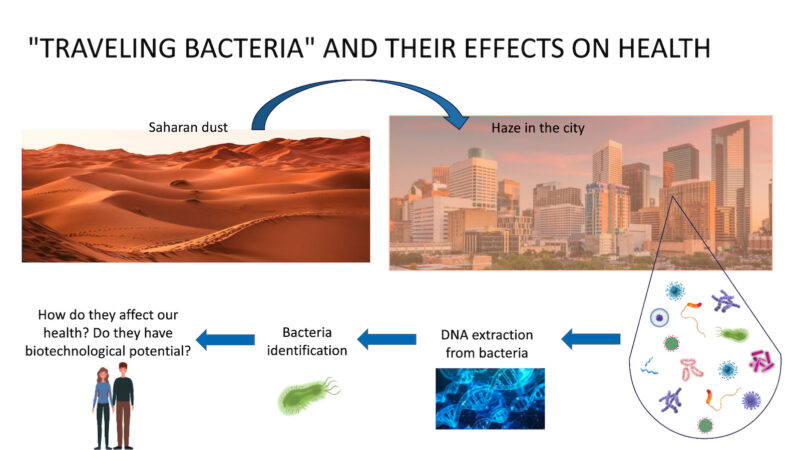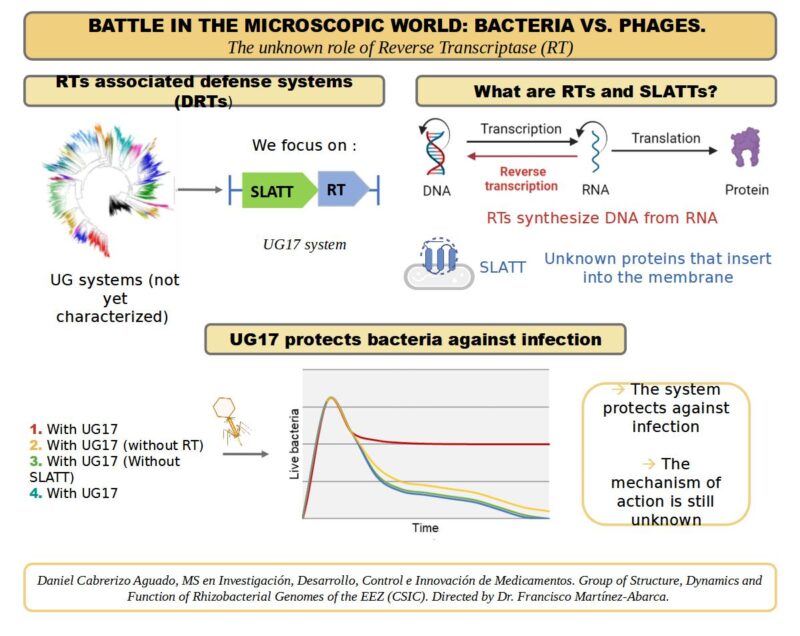Battle in the microscopic world: bacteria vs. phages – Daniel Cabrerizo Aguado
The fight against resistant microorganisms – Mercy Elizabeth Quizhpe Romero
“Travelling bacteria” and their impact on health – Irene de Pablos Florido
Máster en Investigación, Desarrollo, Control e Innovación de Medicamentos

Atmospheric pollution is the presence in the air of chemical, physical or biological agents that alter its natural characteristics. It is currently one of the greatest environmental health risks.
Desert dust outbreaks lead to increased concentrations of particulate matter in the atmosphere. These dust particles have been shown to be an excellent vehicle for the transport of microorganisms. This is a cause for concern, as the particles can travel thousands of kilometers for several weeks, crossing oceans and continents, thus facilitating the spread of infectious agents.
Our objective is to determine the presence of these traveling bacteria in samples of Saharan dust, collected in the Canary Islands, a region particularly affected by calima or dust rain events. To do so, we extract the genetic material (DNA) from the bacteria and then purify it; in this way we can identify the bacteria and find out whether they have already been described or if, on the contrary, they were previously unknown.
Once identified, we can test their resistance to extreme conditions, such as UV light or low temperatures, in order to find out more about their possible impacts on health and their possible biotechnological potential.
Keywords: microorganisms, dust particles, haze, health, biotechnological potential.
Directed by: Ana del Moral García

Antimicrobials are substances that inhibit the growth of certain pathogenic microorganisms and can therefore be used in the treatment of the diseases they cause. However, some microorganisms have developed resistance mechanisms to these substances.
This poses a major threat to global health as resistance makes the antimicrobials less effective, making it more difficult to treat several infections, prolonging hospital stays and increasing mortality. This problem is becoming more serious as antimicrobial resistance is increasing worldwide to dangerous levels.
Several strategies are currently being employed in the fight against resistant microorganisms. One involves the use of new natural products produced by certain microorganisms as a source of antimicrobials. It consists of exploring new environments different from those traditionally explored. The aim is to isolate microorganisms that produce new molecules that have activity against resistant pathogens. These molecules could then be considered as candidates for drugs to treat these infections. With this in mind, this Master’s Thesis aims to analyse the activity of substances produced by previously isolated strains of a genus of actinomycetes (a type of bacteria), in order to evaluate their antimicrobial activity.
Keywords: resistant microorganisms, antimicrobial, natural products, drugs, actinomycetes.
Directed by: Ignacio González Martínez/Daniel Oves Costales

Bacteria, like all living beings, defend themselves against infectious agents, in this case mainly viruses known as “phages”. The mechanisms are extremely diverse and vary from one bacterium to another. Many are not yet fully understood. Recent research showed that many of these systems involve proteins called “Reverse Transcriptases” (RTs). RTs are enzymes that manufacture DNA (where the genetic material is stored), using RNA, an intermediary between DNA and protein, as a template. By the end of 2021, more than 30 bacterial defence systems associated with these RTs had been described. In this project we focused on one of these systems, known as UG17. This system is found in bacteria of the genus Salmonella and Escherichia, among others, and is characterized by the fact that the RT is associated with another protein called SLATT, which is predicted to form pores in the membrane. Although their role in the defence mechanism is still unknown, we demonstrated that the protection of bacteria against infection by some phages requires the participation of both RT and SLATT.
Keywords: Defence systems; UG17; Reverse transcriptase; SLATT
Directed by: Francisco Martínez-Abarca Pastor